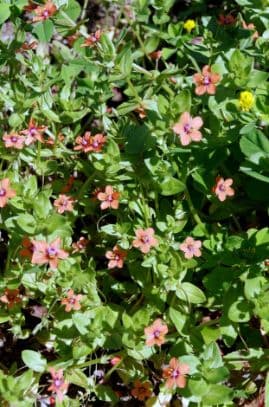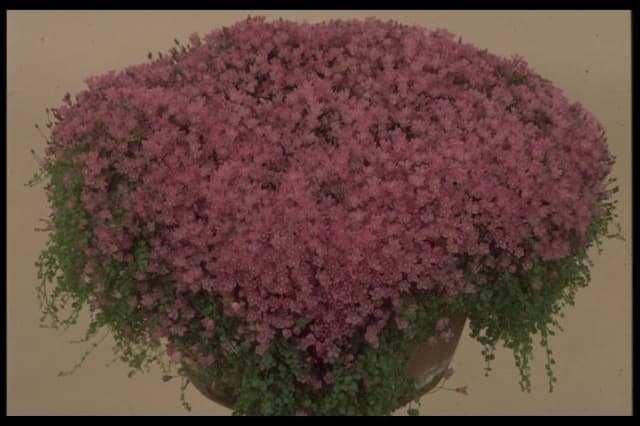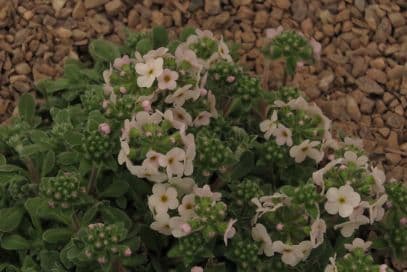Eastern Cyclamen Cyclamen coum 'Meaden's Crimson'

ABOUT
Cyclamen coum 'Meaden's Crimson', commonly known as Eastern cyclamen, is a flowering perennial that is noted for its vibrant, ornate flowers and attractive foliage. This plant blooms in the late winter to early spring, displaying a starry array of deep crimson-red flowers which have a distinctive, upwards-facing posture. Each flower comprises five reflexed petals, which gracefully curve back to create a sense of elegance and movement. The heart-shaped leaves of the Eastern cyclamen add further interest, with their dark green coloration set off by a silver or pale green marbling pattern that varies from leaf to leaf. The foliage itself forms a low-growing, ground-hugging mound that provides a lush backdrop to the striking flowers. The overall effect of the Cyclamen coum 'Meaden's Crimson' is one of vibrant color contrast and delicate beauty that brightens the landscape during the cooler seasons, offering a splash of warmth with its crimson blooms amid the surrounding greenery. The plant radiates a certain charm and is often prized by gardeners for its winter flowering capability and the splash of color it adds when most plants are dormant.
About this plant
 Names
NamesSynonyms
Eastern Cyclamen, Persian Violet, Spring Sowbread.
Common names
Cyclamen coum 'Meaden's Crimson'.
 Toxicity
ToxicityTo humans
Persian violet is considered toxic if ingested due to the presence of saponins and other compounds. Symptoms of poisoning can include nausea, vomiting, and diarrhea. Contact with the skin can sometimes cause an allergic reaction. The highest concentration of toxic compounds is typically found in the tubers, so accidental ingestion of these parts can result in more severe symptoms. Ingestion can also potentially lead to convulsions, paralysis, and in extreme cases, can be fatal.
To pets
Persian violet is also toxic to pets, such as cats and dogs. Similar to humans, the ingestion of any part of the plant, especially the tubers, can lead to symptoms like vomiting, diarrhea, and excessive drooling. In severe cases, ingestion can cause heart rhythm abnormalities, seizures, and even death. Pet owners should take care to prevent pets from accessing or ingesting this plant.
 Characteristics
CharacteristicsLife cycle
Perennials
Foliage type
Evergreen
Color of leaves
Green
Flower color
Crimson
Height
0.5 feet (15 cm)
Spread
0.5 feet (15 cm)
Plant type
Bulb
Hardiness zones
5
Native area
Mediterranean
Benefits
 General Benefits
General Benefits- Early Spring Blooms: Cyclamen coum 'Meaden's Crimson' provides a splash of vibrant crimson-pink flowers in late winter to early spring when few other plants are in bloom.
- Attracts Pollinators: The flowers are a nectar source for early-season pollinators such as bees, which is crucial when few other food sources are available.
- Low Maintenance: Once established, it requires minimal care, being tolerant of neglect and capable of thriving in less than ideal conditions.
- Drought Resistant: This plant is relatively drought-tolerant once established, making it suitable for xeriscaping or areas with water restrictions.
- Ground Cover: Its spreading habit makes it an excellent choice for ground cover, helping to suppress weeds and stabilize soil with its root system.
- Deer and Rabbit Resistant: Cyclamen coum is generally not preferred by deer and rabbits, which can help to ensure its survival and bloom in wildlife-rich areas.
- Versatility: It can be planted in a variety of settings, from rock gardens to woodland plantings or as underplanting beneath deciduous trees and shrubs.
- Winter Interest: The patterned and sometimes silver-veined foliage provides visual interest during the winter months, even when not in flower.
- Compact Growth: Its small size and compact growth habit make it suitable for use in containers, borders, and small gardens where space is limited.
- Long-Lived Perennial: It is a perennial that can live for many years, becoming a long-term presence in the garden with minimal replacement.
 Medical Properties
Medical PropertiesThis plant is not used for medical purposes.
 Air-purifying Qualities
Air-purifying QualitiesThis plant is not specifically known for air purifying qualities.
 Other Uses
Other Uses- Flower Arrangements: Cyclamen's vibrant crimson flowers can be cut and used in small posies or floral arrangements to add a splash of color during late winter months.
- Education and Research: Cyclamen coum can be used in botanical studies due to their interesting pollination mechanisms, which involve their petals bending backwards as the flower matures.
- Photography Subject: Due to its striking appearance, Cyclamen coum makes an excellent subject for botanical photography, particularly useful for those specializing in close-up plant portraits.
- Art Inspiration: Artists may draw inspiration from the delicate form and vivid color of Cyclamen for paintings, illustrations, and fabric designs.
- Craft Projects: Dried Cyclamen flowers can be incorporated into craft projects, such as handmade paper, bookmarks, or pressed flower art.
- Winter Gardens: Cyclamen coum can be utilized to create a winter-interest garden due to its ability to flower in colder months when most other plants are dormant.
- Eco-friendly Confetti: The petals of Cyclamen can be used as a natural and biodegradable confetti alternative for outdoor celebrations.
- Bee Forage: Despite their unusual flowering time, the nectar and pollen of Cyclamen flowers provide an essential food source for bumblebees and other pollinators active in winter.
- Frost Tolerance Demonstration: Cyclamen coum can serve as an example in educational settings for plants that are tolerant of frost, as they often emerge through snow.
- Seasonal Celebrations: Cyclamen can be incorporated into decor for seasonal celebrations like Christmas and Valentine's Day due to their festive colors and winter blooming period.
Interesting Facts
 Feng Shui
Feng ShuiCyclamen is not used in Feng Shui practice.
 Zodiac Sign Compitability
Zodiac Sign CompitabilityCyclamen is not used in astrology practice.
 Plant Symbolism
Plant Symbolism- Deep Love: Cyclamen, often associated with deep love, due to its heart-shaped leaves and vibrant colors that stand out during the late winter and early spring months, symbolizes the deep and enduring feelings one person can have for another.
- Parting: In the language of flowers, giving someone cyclamen flowers may imply a farewell or a desire to part, perhaps because the plant goes dormant and appears to die, only to return with renewed life.
- Sincerity: The vibrant and unassuming beauty of cyclamen is thought to represent sincerity and genuine emotion, lacking pretense or deception.
- Maternal Love: In some cultures, the plant symbolizes a mother's enduring love, with its nurturing growth and re-flowering nature reflecting a mother's care and devotion.
 Water
WaterThe Eastern Cyclamen requires moderate watering, ensuring the soil is kept moist but not waterlogged. Water the plant when the top inch of soil feels dry to the touch, which typically could be once or twice a week, depending on environmental conditions. Use lukewarm water and avoid wetting the leaves to prevent rot. During its active growth period in fall and winter, this might equate to approximately 8-16 ounces of water weekly. In the dormant summer period, reduce watering significantly, allowing the soil to dry out more between waterings.
 Light
LightFor the Eastern Cyclamen, bright, indirect light is ideal. They thrive in a north or east-facing window where they receive some morning sun but are protected from the harsh afternoon sunlight. Avoid placing them in direct sunlight, especially during the summer months, as this can scorch the leaves and flowers.
 Temperature
TemperatureEastern Cyclamen prefers cool conditions with temperatures ranging between 50°F and 68°F. They can tolerate temperatures as low as 40°F and as high as 70°F, but prolonged exposure outside of their preferred range can be detrimental. The ideal temperature for robust growth is around the middle of their range, about 60°F.
 Pruning
PruningEastern Cyclamen benefits from minimal pruning, mainly to remove yellowing or dead leaves and spent flowers to encourage new growth and maintain the plant's appearance. The best time for pruning is after flowering, usually in late winter or early spring. Remove the leaves and flowers by gently pulling them away from the corm to avoid damaging the plant.
 Cleaning
CleaningAs needed
 Soil
SoilEastern Cyclamen thrives best in a soil mix consisting of equal parts of loamy soil, peat, and sharp sand to ensure good drainage. The ideal soil pH for Eastern Cyclamen should be slightly acidic to neutral, ranging from 6.5 to 7.0.
 Repotting
RepottingEastern Cyclamen typically does not need to be repotted often and can be done every few years. Repot the plant when it outgrows its current container or when the soil is exhausted, usually after the dormancy period in summer.
 Humidity & Misting
Humidity & MistingEastern Cyclamen prefers moderate to high humidity levels, ideally between 50-70%. To maintain these humidity conditions, keep the plant away from dry air sources and consider using a humidity tray or room humidifier if needed.
 Suitable locations
Suitable locationsIndoor
Place Eastern Cyclamen in bright, indirect light and keep soil moderately moist.
Outdoor
Plant Eastern Cyclamen in partial shade; ensure soil is well-draining and sheltered.
Hardiness zone
5-9 USDA
 Life cycle
Life cycleCyclamen coum 'Meaden's Crimson', commonly known as Eastern cyclamen, initiates its life cycle by germinating from a tuber, typically in the fall. Upon sprouting, it produces a rosette of heart-shaped leaves and flowers that range in color from pink to crimson during late winter or early spring. After pollination, usually by insects, the flower stems coil down, bringing the developing seed pods to ground level. Throughout the spring, the plant continues to grow and the seed pods mature, eventually releasing seeds into the soil. As temperatures rise in late spring or early summer, the plant enters dormancy, with leaves dying back to conserve energy within the tuber. The cycle resumes when cooler temperatures and moisture stimulate the tuber to break dormancy and the plant begins a new growth cycle in the fall.
 Propogation
PropogationPropogation time
Late winter-early spring
Cyclamen coum 'Meaden's Crimson', commonly known as the Eastern Cyclamen, is often propagated through its seeds. The optimal time to sow the seeds is after they mature, which generally happens in late summer to early fall. Fresh seeds are sowed on the surface of a well-draining seed compost mix and then covered with a thin layer of compost or vermiculite. To maintain a humid environment, the container can be covered with glass or plastic. The ideal germination temperature is around 65°F (approximately 18°C), and it can take several weeks to a few months for the seeds to germinate. It's essential to keep the soil consistently moist but not waterlogged during this period. Gently transplant the seedlings to individual pots once they are large enough to handle.









